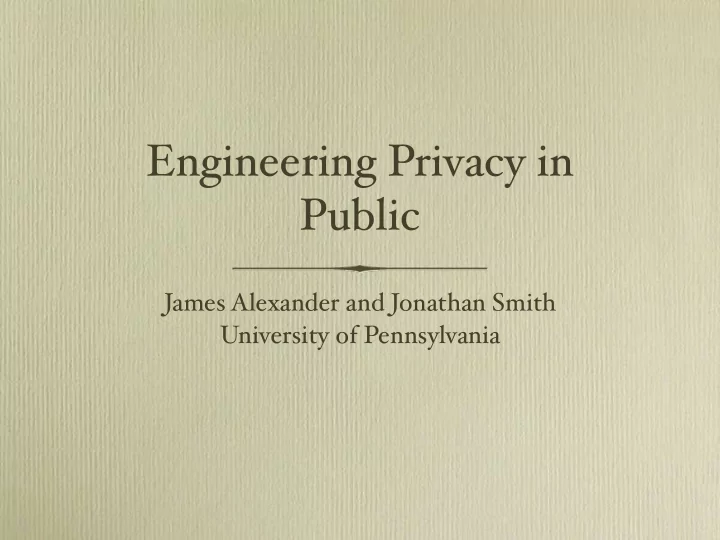

Engineering Privacy in Public James Alexander and Jonathan Smith University of Pennsylvania
Introduction • Project Goal: A generalized, experimentally� validated privacy metric • First experiment: Defeating face recognition • Experiments with more biometrics to follow
Talk Overview • Project Goals • Face Recognition: Methodology and Evaluation • Disguise Slide Show • Analysis • Future W ork
V alue of PET Generality • Though details differ wildly, the goal of all PETs is the same: to help the user not be identified • Advantages of a common framework: • User can tell where they get the most “bang for the buck” • Easier to evaluate the combination of severals PETs in the presence of multimode surveillance
Project Goal To develop a “benefit” metric for evaluation of privacy enhancing technologies • Propose candidate metrics and evaluate against empirically�measured PET performance
General Properties • Suitable for cost / benefit analysis regardless of how cost is quantified • Explainable to a lay person • Places reliable bounds on how well an adversary can do, even without precise knowledge of adversary’s methods
Modeling Privacy Adversary knows some predicate holds of a particular individual • He builds a probability distribution of this predicate over the set of all individuals • Job of a PET is to make sure the correct individual does not stand out in the distribution
identity noisy channel
identity face disguise obstructions camera
identity user network interface mix network adversary network interface(s)
identity loyalty card munged identifying info + card swapping grocer customer database
Challenges • W e want to predict entropy in the adversary’s model � we can’t measure it directly, but perhaps can place bounds on it • Theory of non�cooperating communicators is not well�explored • What are the limits of a communication channel employing a sabotaged encoding? • What if noise sources are not random?
Methodolgy • Tested face recognition system an eigenfaces system used in the FERET evaluation • 3816 FERET images used as distractors • New pictures added to match FERET specs • Facial occlusion images from AR database give statistical behavior of two particular disguises
Sample Baselines
AR Sample
Adversary Model • Can obtain high�quality frontal probe images • Might have more than one gallery image of you • System output will consist of up to N candidate matches, presented to an operator for confirmation • Face recognition system will be deployed on a large scale • Do not know if a minimum likelihood cut�off used
Score Function N − i + 1 if the candidate in the i th position w x ( i ) = is really x (i.e. a match) 0 otherwise � N i =1 w x ( i ) score( x ) = � N i =1 i
Effective Disguises
AR performance Image group Accuracy Mean Score baseline 99.6� 0.6947 sunglasses 15.0� 0.0344 scarf 58.7� 0.2323 overall 45.8� 0.2136
A minor di ffi culty • Problem: The score function doesn’t allow performance comparison among disguises that all score zero • Solution: Mo rphs!
Ineffective Disguises
What’s going on? • The system is attempting to match facial features and their positions to the closest matches in its training data • To fool it, we need to obscure or remove existing features, or provide decoy features for it to find • Features are composed of contrasts in the photographic data
Grid Model
A Grid in the Noisy Channel identity
Refining the Grid Experiments in progress in order to determine: • The critical size separating features from non� features �i.e. the right size of grid boxes� • The weights representing the differing importance of each grid position to system performance
An anomaly
Performance T rade�offs 1 accuracy ave score false negatives 0.8 0.6 0.4 0.2 0 200 250 300 350 400 450 500 550 600 650 700 similarity
Future W ork • Elaborate the grid model further • Test disguises on more subjects • Replicate with a face recognition system with a very different underlying model �e.g. FaceIt� • Extend framework to more biometrics, and beyond
Questions?
Recommend
More recommend